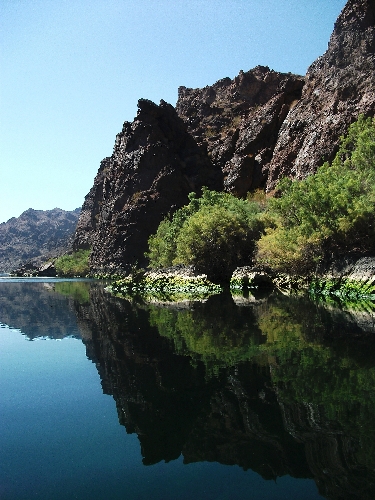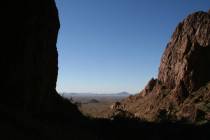Quiet Black Canyon river trip awaits

People come from throughout the world to visit Black Canyon, the 12-mile gorge of the Colorado River running downstream from Hoover Dam to Willow Beach, Ariz. Yet, even though it is practically in our backyards, many Southern Nevadans have not even heard of it, let alone cruised its waters.
The best way to see the canyon is by renting a kayak or canoe and traveling downstream. The views upstream at the towering Hoover Dam, at the surrounding cliffs, and at the new Mike O’Callaghan-Pat Tillman Memorial Bridge, are particularly impressive from a seat at water level. Your chances of seeing wildlife are better from a kayak or a canoe than any other conveyance. And you’re the captain of your own little craft, paddling where you like at your preferred velocity.
You can’t just drive yourself down the portal road, as security is tight. However, there are several companies that will get you security clearance, then transport you and your craft to water’s edge, give you a detailed map, and launch you – or if you prefer, guide you – on your adventure.
Once you are in the water, fun begins immediately. After drinking in the fine view of the dam, towering more than 700 feet above the water and seeing the new bypass bridge that so gracefully arches from Nevada to Arizona, it’s only 1½ miles downriver to a lovely little waterfall. Its water is bath-warm. The waterfall lies next to Lone Palm Canyon, named for the original Mexican fan palm that grew here. Just a short paddle from here on the Nevada bank, you will find Gold Strike Canyon, where a soak in the warm water is by itself worth the trip.
Black Canyon’s walls are steep, so there aren’t usually many places to stop. But if the water level doesn’t happen to be very high the day of your visit, a few very nice little beaches will be exposed. Even though the water is a decidedly cool 55 degrees, a quick and invigorating swim, followed by a contrasting, deliciously warm bake on the clean river strand, will be a combination of pleasures you won’t soon forget.
The surrounding terrain is rugged and steep for most of the way downriver, but bighorn sheep don’t have much trouble traversing it. I have personally seen some every time I have taken this trip. And over two different trips within the last three weeks, I even saw herds, including spunky young lambs. Look to the sky as well as the cliffs; I have spotted osprey, great blue herons and even a bald eagle recently.
Another place worth stopping is Arizona Hot Springs, just a five-minute walk (and wade) following a warm little stream up its narrow canyon. And on the Nevada side of the river, most kayakers enjoy a quick paddle into Weeping Springs Cove, where you will find a dripping spring that cascades down the cove’s steep walls.
About 10 miles into your downstream journey, you will see a wire attached high on the cliff walls, and crossing the river, a small and very old trolley hung from the wire. Below this, on the Nevada side, you will see a gauging station used prior to the construction of the dam. The gauger came across this trolley to measure water levels, flows and such. A little downriver from the trolley, look carefully on the cliff faces of the Arizona side to see the remains of the catwalk he used to commute to and from his home.
You can get out of your little craft and walk up to the remains of that very home, about a half-mile below the gauging station, on the Arizona side.
Back in your boat, you’ll round one more bend of the river and will come back to civilization. On your left will lie the Willow Beach National Fish Hatchery, then the Willow Beach Marina, and immediately thereafter the beach which serves as the take-out point for kayaks and canoes. Here the company that launched you will load your gear and then shuttle you back to your vehicle, which you will have left at the Hacienda Hotel between Boulder City and Hoover Dam.
Sundays and Mondays are the best time to do this trip, as privately owned motorized vessels are not allowed up river from Willow Beach. This not only cuts down on the crowds at some of the highlights I mentioned but also leaves the river wake-free and serene and increases your chances of seeing wildlife. Reservations are needed as far in advance as possible, as they fill up fast.
Deborah Wall is the author of "Great Hikes, A Cerca Country Guide" and "Base Camp Las Vegas: Hiking the Southwestern States," published by Stephens Press. She can be reached at deborabus@aol.com.












